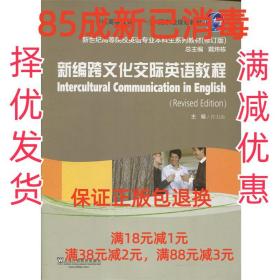
【85成左右新】新编简明英语语言学教程 戴炜栋,何兆熊,戴炜栋上
【85成左右新】有写过的痕迹但是笔记很少,整体很新,正版,无附件和增值服务等。
¥ 4.36 1.5折 ¥ 30 八五品
库存3819件
作者戴炜栋,何兆熊,戴炜栋
出版社上海外语教育出版社
ISBN9787544653060
出版时间2018-05
版次1
装帧平装
开本16开
纸张胶版纸
页数199页
定价30元
货号9787544653060
上书时间2023-08-12
- 最新上架
商品详情
- 品相描述:八五品
- 【书非常新,有少许笔记】但不影响阅读,无附件和增值服务等。
- 商品描述
-
基本信息
书名:新编简明英语语言学教程
定价:30.00元
作者:戴炜栋,何兆熊,戴炜栋
出版社:上海外语教育出版社
出版日期:2018-05-01
ISBN:9787544653060
字数:
页码:199
版次:
装帧:平装
开本:16开
商品重量:
编辑推荐
内容提要
本系列教材按照英语专业教学大纲设计,旨在打造完整的英语专业学科体系,全面促进学生的语言技能、学科素养和创新能力的培养,为我国培养国际化、创新型、高素质的英语专业人才奠定基础。本次整合改版并重新设计装帧后出版,以更好地适应市场需求。 《新编简明英语语言学教程(第2版)/新世纪高等院校英语专业本科生系列教材(修订版)》为其中的语言学教程,供语言学课程使用。
目录
Chapter 1 Introduction1.1 What is linguistics?1.1.1 Definition1.1.2 The scope of linguistics1.1.3 Some important distinctions in linguistics1.2 What is language?1.2.1 Definitions of language1.2.2 Design features of language1.2.3 Functions of languageRevision exercisesFor further readingChapter 2 Phonology2.1 The phonic medium of language2.2 Phonetics2.2.1 What is phonetics?2.2.2 Organs of speech2.2.3 Orthographic representation of speech sounds ——broad and narrow transcriptions2.2.4 Classification of English speech sounds2.3 Phonology2.3.1 Phonology and phonetics2.3.2 Phone, phoneme, and allophone2.3.3 Phonemic contrast, complementary distribution, and minimal pair2.3.4 Some rules in phonology2.3.5 Suprasegmental features —— stress, tone, intonationRevision exercisesFor further readingChapter 3 Morphology3.1 Introduction3.2 Open class and closed class3.3 Morphemes —— the minimal units of meaning3.4 Analyzing word structures3.5 Derivational and inflectional morphemes3.6 Morphological rules of word formation3.7 Derivation3.8 CompoundsRevision exercisesFor further readingChapter 4 Syntax4.1 What is syntax?4.2 Categories4.2.1 Word-level categories4.2.2 Phrase categories and their structures4.3 Phrase structure rule4.3.1 XPrule4.3.2 Coordination rule4.4 Phrase elements4.4.1 Specifiers4.4.2 Complements4.4.3 Modifiers4.5 Sentences (The S rule)4.6 Transformations4.6.1 Auliary movement4.6.2 Do insertion4.6.3 Deep structure and surface structure4.6.4 Wh movement4.6.5 Move a and constraints on transformationsRevision exercisesFor further readingChapter 55.1 What is semantics?5.2 Some views concerning the study of meaning5.2.1 The naming theory5.2.2 The conceptualist view5.2.3 Contextualism5.2.4 Behaviorism5.3 Lecal meaning5.3.1 Sense and reference5.3.2 Major sense relations5.4 Sense relationetween sentences5.5 Analysis of meaning5.5.1 Componential analysis —— a way to analyze lecal meaning5.5.2 Predication analysis —— a way to analyze sentence meaningRevision exercisesFor further readingChapter 6 Pragmatics6.1 Some basic notions6.1.1 Definition6.1.2 Pragmatics vs. semantics6.1.3 Context6.1.4 Sentence meaning vs. utterance meaning6.2 Speech act theory6.2.1 Austin's model of speech acts6.2.2 Searle's classification of speech acts6.2.3 Indirect speech acts6.3 Principle of conversation6.4 Cross-cultural pragmatic failureRevision exercisesFor further readingChapter 7 Language Change7.1 Introduction7.2 Phonological changes7.3 Morphological and syntactic change7.3.1 Addition of affixes7.3.2 Loss of affixes7.3.3 Change of word order7.3.4 Change in negation rule7.4 Lecal and semantic change7.4.1 Addition of new words7.4.2 Loss of words7.4.3 Semantic changes7.5 Some recent trends7.5.1 Moving towards greater informality7.5.2 The influence of American English7.5.3 The influence of science and technology7.6 The causes of language changeRevision exercisesFor further readingChapter 8 Language and Society8.1 The scope of sociolinguistics8.1.1 The relatednesetween language and society8.1.2 Speech community and speech variety8.1.3 Two approaches to sociolinguistic studies8.2 Varieties of language8.2.1 Dialectal varieties8.2.2 Register8.2.3 Degree of formality8.3 Standard dialect8.4 Pidgin and Creole8.5 Bilingualism and diglossiaRevision exercisesFor further readingChapter 9 Language and Culture9.1 Introduction9.2 What is culture?9.3 The relationship between language and culture9.4 Sapir-Whorf Hypothesis9.5 Linguistic evidence of cultural differences9.5.1 Greetings and terms of address9.5.2 Gratitude and compliments9.5.3 Colour words9.5.4 Privacy and taboos9.5.5 Rounding off numbers9.5.6 Words and cultural-specific connotations9.5.7 Cultural-related idioms, proverbs and metaphors9.6 Culture contact, cultural overlap and diffusion9.7 The significance of cultural teaching and learning9.8 Intercultural communicationRevision exercisesFor further readingChapter 10 Language Acquisition10.1 Introduction10.2 Theories of child language acquisition10.2.1 A behaviourist view of language acquisition10.2.2 An innatist view of language acquisition10.2.3 An interactionist view of language acquisition10.3 Cognitive development in child language development10.4 Language environment and the Critical Period Hypo thesis10.5 Stages in child language development10.5.1 Phonological development10.5.2 Vocabulary development10.5.3 Grammatical development10.5.4 Pragmatic development10.6 Atypical developmentRevision exercisesFor further readingChapter 11 Second Language Acquisition11.1 Introduction11.2 Connectionetween first language acquisition and second language acquisition11.3 Contrastive analysis11.4 Error analysis11.5 Interlanguage11.6 The role of the native language in second language learning11.7 Second language learning models and input hypothesis11.8 Individual differences11.9 Second language acquisition and its pedagogical implicationsRevision exercisesFor further readingChapter 12 Language and the Brain12.1 Introduction12.2 Neurolinguistics12.2.1 What is neurolinguistics?12.2.2 The struce and function of the human brain12.2.3 Methods for the study of the brain and evidences for lateralization12.2.4 Aphasia12.3 Psycholinguistics12.3.1 What is psycholinguistics?12.3.2 Psycholinguistic research methods12.3.3 Linguistics and language processing12.3.4 Psycholinguistic modelingRevision exercisesFor further readingA Glossary in English and ChineseReferences
作者介绍
序言
-

【封面】
相关推荐
-
![【85成左右新】简 爱 [英]勃朗特(BronteE.),草莓阅读湖南教育](https://www0.kfzimg.com/sw/kfz-cos/kfzimg/3318881/5bf6cc4b37b2b629_s.jpg)
【85成左右新】简 爱 [英]勃朗特(BronteE.),草莓阅读湖南教育
八五品杭州
¥ 1.15
-

【85成左右新】杰瑞的冷静太空 (美)简·尼尔森(Jane Nelsen) 著,
八五品杭州
¥ 5.00
-

【85成左右新】麦肯锡极简工作法 刘易斯 著天津科学技术出版社【
八五品杭州
¥ 2.81
-
![【85成左右新】傲慢与偏见 [英]简·奥斯汀晨光出版社【笔记很少](https://www0.kfzimg.com/sw/kfz-cos/kfzimg/3318881/8456d76c75b896dd_s.jpg)
【85成左右新】傲慢与偏见 [英]简·奥斯汀晨光出版社【笔记很少
八五品杭州
¥ 2.04
-

【85成左右新】社会调查教程精编本(新编21世纪社会学系列教材;
八五品杭州
¥ 10.03
-

【85成左右新】新编跨文化交际英语教程 上海外语教育出版社【笔
八五品杭州
¥ 1.53
-

【85成左右新】新编大学英语 外语教学与研究出版社【笔记很少,
八五品杭州
¥ 6.63
-

【85成左右新】新编仪器分析 高向阳科学出版社【笔记很少,整体
八五品杭州
¥ 10.88
-

【85成左右新】新编国际货运代理专业英语 中国国际货运代理协会
八五品杭州
¥ 3.94
-

【85成左右新】新编大学英语自主听力教程 李勇 主编人民交通出
八五品杭州
¥ 1.53
— 没有更多了 —











以下为对购买帮助不大的评价